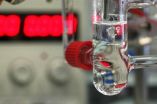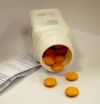(Press-News.org) The Johns Hopkins researchers who first showed that the commonly used blood pressure drug losartan may help prevent life-threatening aneurysms of the aorta in patients with Marfan syndrome have now discovered new clues about the precise mechanism behind the drug's protective effects.
The team's findings not only answer many lingering questions — including how exactly the drug works and whether other classes of blood-pressure medication may work as well as or better than losartan — but also identify new targets for treating Marfan and other connective-tissue disorders.
In two separate papers published in the April 15 issue of Science, the researchers show that losartan neutralizes a rogue protein and in doing so halts the dangerous ballooning of the heart's main blood vessel, the aorta.
"Our research has decoded the exact cascade of events triggered by the genetic glitch in Marfan that culminates in weakening of the aorta, its gradual enlargement and tearing," says senior investigator Harry "Hal" Dietz, M.D., a cardiologist at Johns Hopkins Children's Center, professor in the McKusick-Nathans Institute of Genetic Medicine at Hopkins and director of the William S. Smilow Center for Marfan Research.
"Understanding the cellular cascade leading up to Marfan's most serious complication will allow us to design therapies that precision-target each step in this harmful sequence of events," Dietz adds.
Dietz's research has previously shown that the dangerous stretching of the aorta in those born with the genetic disorder stems from the excessive activity of a protein called TGF-beta, believed to cause damage by setting off aberrant signals inside cells that make up blood vessels. The new research, conducted in mice that were genetically engineered to develop Marfan, identifies one of these signals as a critical communication channel that sets off a dangerous cross-talk between TGF-beta and a protein called ERK. TGF-beta activates ERK, which causes the aorta to stretch and grow aneurysms, the researchers found.
The research further shows that two other proteins, AT1 and AT2, play opposing roles in the cross-talk between TGF-beta and ERK, and that turning one off while keeping the other intact is critical in preventing aneurysms. Researchers have long suspected that AT1 can cause damage to the aorta by activating TGF-beta, but AT2's role has remained unclear — until now.
To explain the role of AT2 in aneurysm formation, the researchers treated mice with Marfan with either losartan, a known inhibitor of AT1, or enalapril, a drug that shuts off both AT1 and AT2. The aortas of mice treated with losartan stopped growing in the area where aneurysms tend to form. Mice treated with enalapril, however, showed barely any improvement. The discovery led researchers to conclude that blocking the AT1 alone can slow growth and avert aneurysm formation, but blocking both AT1 and AT2 would not. In other words, keeping AT2 intact halted the dangerous interplay between TGF-beta and ERK. Losartan blocked AT1 but spared AT2, thus turning off ERK. Enalapril shut off both and had no effect on ERK.
Because TGF-beta is already a suspect in other connective-tissue diseases, these new revelations about its modus operandi may pave the way to new therapies for such disorders, the investigators say.
"Precision-targeting AT1 to shut it off, while leaving AT2 intact is the way to go," says lead author Jennifer Pardo Habashi, M.D., a cardiologist at Hopkins Children's. "Now that we know what makes losartan so effective, we can start looking for other medications that may be even better at preventing aortic damage."
The investigative team also tested a candidate compound that selectively blocks ERK and showed that it completely halted aneurysm growth in mice with Marfan. Yet another compound that blocks another one of TGF-beta's communication channels, called JNK, was nearly as effective in curbing aneurysm growth.
Dietz identified the Marfan gene in the 1990s and led the scientific team that in 2006 first described losartan's effect on the aorta.
A small Hopkins study in children has already shown that losartan can slow enlargement of the aorta over time. Based on these findings, larger clinical trials are already under way at Hopkins Children's and other institutions.
###
Other Hopkins researchers involved in the two studies were Tammy Holm, Jefferson Doyle, Djahida Bedja, YiChun Chen, Christel van Erp, Hamza Aziz, Mark Lindsay, David Kim, Daniel Judge, Alexandra Modiri, Florian Schoenhoff and Ronald Cohn.
Co-investigators from other institutions included Bart Loeys of Ghent University in Belgium, and Craig Thomas, Samarjit Patnaik, and Juan Marugan, of the National Institutes of Health.
The research was funded by the National Institutes of Health, the Howard Hughes Medical Institute, the Smilow Center for Marfan Research at Hopkins and The National Marfan Foundation.
Related on the Web:
Marfan, A ''Look-Alike'' Disorder, or Neither?
http://www.hopkinschildrens.org/Marfan-A-Look-Alike-Disorder-or-Neither.aspx
Drug Treatment for Marfan Syndrome Looks Promising
http://www.hopkinschildrens.org/drug-treatment-marfan-syndrome.aspx
Marfan Foundation
http://www.marfan.org
Hopkins research sheds light on aortic aneurysm growth, treatment in Marfan syndrome
2011-04-15
ELSE PRESS RELEASES FROM THIS DATE:
Streamlining Inspection in Upstream Oil & Gas Well Sites in Energy Digital
2011-04-15
The April issue of Energy Digital is available to read exclusively online to all energy industry leaders from around the globe. This month's issue features a unique new system for well site inspection to boost safety and efficiency.
Industry leaders turn to Energy Digital for the latest news about cutting edge energy technologies, global energy infrastructure, developments in green and sustainable energy and the corporate activity in the sector.
Read the full article here.About Energy Digital
Energy Digital is a leading digital media source of news and content for ...
UCSF team describes neurological basis for embarrassment
2011-04-15
Recording people belting out an old Motown tune and then asking them to listen to their own singing without the accompanying music seems like an unusually cruel form of punishment. But for a team of scientists at the University of California, San Francisco and University of California, Berkeley, this exact Karaoke experiment has revealed what part of the brain is essential for embarrassment.
The twist to the experiment was that most of the subjects had neurodegenerative diseases, which helped scientists identify a thumb-sized bit of tissue in the right hemisphere of the ...
A chance discovery may revolutionize hydrogen production
2011-04-15
Producing hydrogen in a sustainable way is a challenge and production cost is too high. A team led by EPFL Professor Xile Hu has discovered that a molybdenum based catalyst is produced at room temperature, inexpensive and efficient. The results of the research are published online in Chemical Science Thursday the 14th of April. An international patent based on this discovery has just been filled.
Existing in large quantities on Earth, water is composed of hydrogen and oxygen. It can be broken down by applying an electrical current; this is the process known as electrolysis. ...
Twitter and Facebook Marketing - Are African Businesses Cashing in on Free Advertising? With African Business Review
2011-04-15
There's no denying that social media, by many once considered a here-today-gone-tomorrow fad, is a key arrow in a marketer's quiver. It's word of mouth on steroids and free, right? Or not.
Social media experts in Kenya and South Africa warn companies not to view social media marketing, on platforms such as Facebook and Twitter, as free. Yes, these platforms are umpteen times more cost-effective that traditional advertising such as TV or print, but do need time, money and strategic thought to be effective.
"Although putting content onto Facebook using fan pages is ...
Illusion can halve the pain of osteoarthritis, scientists say
2011-04-15
A serendipitous discovery by academics at The University of Nottingham has shown that a simple illusion can significantly reduce — and in some cases even temporarily eradicate — arthritic pain in the hand.
By tricking the brain into believing that the painful part of the hand is being stretched or shrunk, the researchers were able to halve the pain felt by 85 per cent of sufferers they tested.
The research could point to new technologies of the future which could assist patients in improving mobility in their hand by reducing the amount of pain they experience while ...
Women more likely to self-medicate
2011-04-15
Approximately 20% of Spaniards take non-prescribed medication and women are the group most inclined towards this practice. This is the conclusion of a research study carried out by experts from the Rey Juan Carlos University in Madrid, which also links this habit to nationality, income level and alcohol and tobacco consumption amongst the population.
"In spite of the negative connotations generally associated with the idea of self-medication, it is actually the most significant method of self-care for the population", explains Pilar Carrasco, main author of the study ...
Manufacturing Digital Predicts the Future of Gaming Starts with the Xbox Kinect
2011-04-15
Motion sensor technology is taking the gaming world by storm. Although it took a long time to reach the shelves, the Xbox Kinect has fully lived up to its hype and expectation after reaching sales figures of 10 million in March 2011 and soon became the fastest selling consumer electronics device of all time, for which it holds a Guinness World Record.
Although the Nintendo Wii still remains the market leader, it seems like the Kinect will soon overtake this industry stalwart in the popularity stakes, with the PlayStation Move hot on its competitor's heels.
Positioned ...
Filtering out pesticides with E. coli
2011-04-15
Genetically modified bacteria could be used in air filters to extract pesticide vapors from polluted air thanks to work by researchers in China published this month in the International Journal of Environment and Pollution.
The bacteria Escherichia coli is perhaps best known as a bacterium that can cause food poisoning and in one form, the O157:H7, can damage the kidneys and even be lethal. However, E coli, is commonly used in biological research as a model organism for a wide range of beneficial experiments. Now, researchers in China have discovered that a genetically ...
CSHL team perfects non-lethal way of switching off essential genes in mice
2011-04-15
Cold Spring Harbor, N.Y. -- One way of discovering a gene's function is to switch it off and observe how the loss of its activity affects an organism. If a gene is essential for survival, however, then switching it off permanently will kill the organism before the gene's function can be determined. Researchers at Cold Spring Harbor Laboratory (CSHL) have overcome this problem by using RNA interference (RNAi) technology to temporarily turn off any essential gene in adult mice and then turn it back on before the change kills the animals.
In a study published online on April ...
inABLE- A Charity for the Blind in Africa- Seeks Supporters to Win April GlobalGiving Open Challenge
2011-04-15
Atlanta-based inABLE races to earn a permanent spot on the GlobalGiving website by mobilizing at least 50 unique donors before the end of April to raise $4,000. Help inABLE win this challenge at http://www.globalgiving.org/projects/computer-labs-for-the-blind.
inABLE shares hope and opportunity by bringing life changing, computer-based educational tools to Africa's blind and visually impaired students. The seed of inspiration behind inABLE was planted in 2008 when Atlanta resident Irene Mbari-Kirika traveled back to her native country Kenya and encountered an engaging ...







